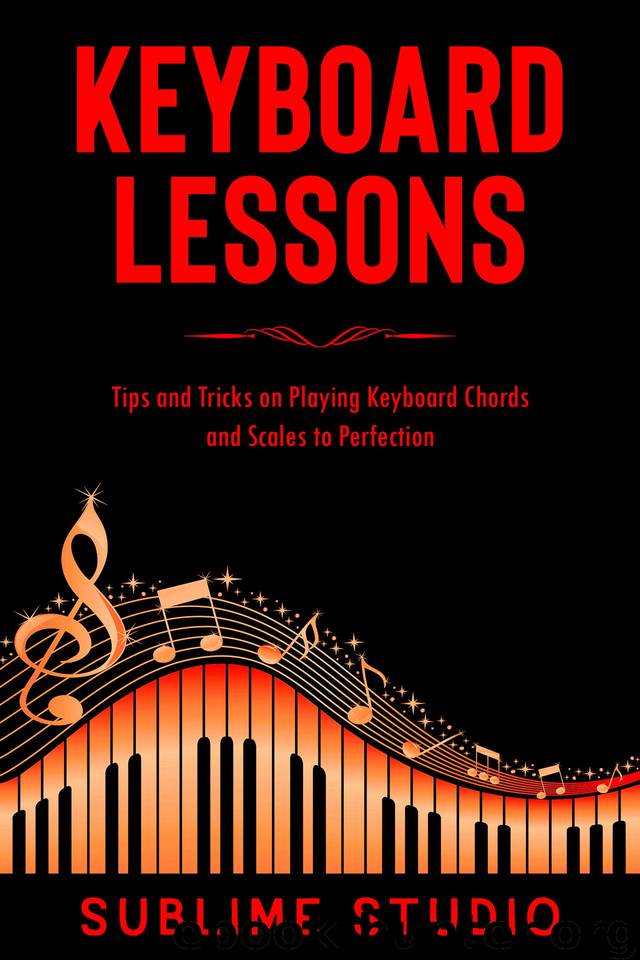KEYBOARD LESSONS: Tips and Tricks on Playing Keyboard Chords and Scales to Perfection by Studio Sublime

Author:Studio, Sublime [Studio, Sublime]
Language: eng
Format: azw3, epub
Published: 2020-06-27T16:00:00+00:00
Harmonic Analysis
Functional Harmony
Harmony not only combines the sound of notes together, but is also responsible for making the piece of music more rich, interesting, and full of texture. When each chord in harmony has a specific function, it is known as a functional harmony. It is used to fix the form of a piece of music.
Harmonic Rhythm
This is used to denote the way in which the chords change from one to another. If the chord of a piece of music changes rarely and slowly, the piece has a harmonic rhythm. If the chords of a music piece change quickly and rapidly, then the piece has a fast harmonic rhythm. Harmonic rhythm, rhythm, and tempos are three distinct parts of the music, and they should not be confused with each other.
Cadence
Cadence is an interesting concept used in all forms of music to make the music richer. When a musician is playing a piece, he or she often reaches a point where the audience thinks the performance has ended. This temporary or permanent halting point is a cadence. Cadence is often used in western music and is closely associated with harmony. Cadence can bring out a sense of thrill and satisfaction for the audience. It can also be used to make the music sound more dramatic and suspenseful.
Diatonic
The diatonic harmony continues to be in either a minor key or a major key.
Chromatic
The chromatic harmony includes many different chords and notes that are not present in the key. It consists of many accidentals.
Dissonance
This includes chords, notes, or intervals that do not fit into traditional harmony. They can be jarring, surprising (or shocking), and unpleasant.
Accompaniment
All the parts of music that are not a melody are the accompaniment. These include bass lines, harmonies, chords, and rhythmic patterns.
Melodic Line
The melodic line is just another word for the different notes that are the constituents of a melody.
Bassline
These include all the different notes that are the lowest notes, either when they are played or sung. The bass line is essential as it provides a line set up for the harmonies in which the other parts of the music can fit in. This is why it is considered to be an essential part of harmony and tuning. Generally, it outlines the progression of the chord, which is why it is considered to be the most apparent of all the visible accompaniment lines.
Inner Parts or Inner Voices
This includes all the parts that serve as the fillers between the bass line and the melody. As mentioned above, the melody is the highest part of the music, and the bass is the lowest part of the music.
Descant
The melody is not always the highest line in a song. People often focus on high notes. The notes that go higher than the particular melody is known as "descant."
Musical Rhythm
Rhythm is perhaps the most basic and crucial element of music. In it, the sounds are placed carefully at the time. Rhythm has multiple components, including meter, accent, and tempo. These components can rarely be separated. Rhythm is surely an integral part of any type of music.
Download
KEYBOARD LESSONS: Tips and Tricks on Playing Keyboard Chords and Scales to Perfection by Studio Sublime.epub
This site does not store any files on its server. We only index and link to content provided by other sites. Please contact the content providers to delete copyright contents if any and email us, we'll remove relevant links or contents immediately.
The Goal (Off-Campus #4) by Elle Kennedy(12423)
Kathy Andrews Collection by Kathy Andrews(10506)
Diary of a Player by Brad Paisley(6863)
What Does This Button Do? by Bruce Dickinson(5519)
Assassin’s Fate by Robin Hobb(5228)
Big Little Lies by Liane Moriarty(4876)
Pale Blue Dot by Carl Sagan(3995)
Sticky Fingers by Joe Hagan(3449)
The Heroin Diaries by Nikki Sixx(2928)
The Death of the Heart by Elizabeth Bowen(2895)
Beneath These Shadows by Meghan March(2712)
The Help by Kathryn Stockett(2700)
Confessions of a Video Vixen by Karrine Steffans(2668)
How Music Works by David Byrne(2519)
Jam by Jam (epub)(2480)
Harry Potter 4 - Harry Potter and The Goblet of Fire by J.K.Rowling(2413)
Strange Fascination: David Bowie: The Definitive Story by David Buckley(2364)
Petty: The Biography by Warren Zanes(2234)
Darker Than the Deepest Sea by Trevor Dann(2205)
